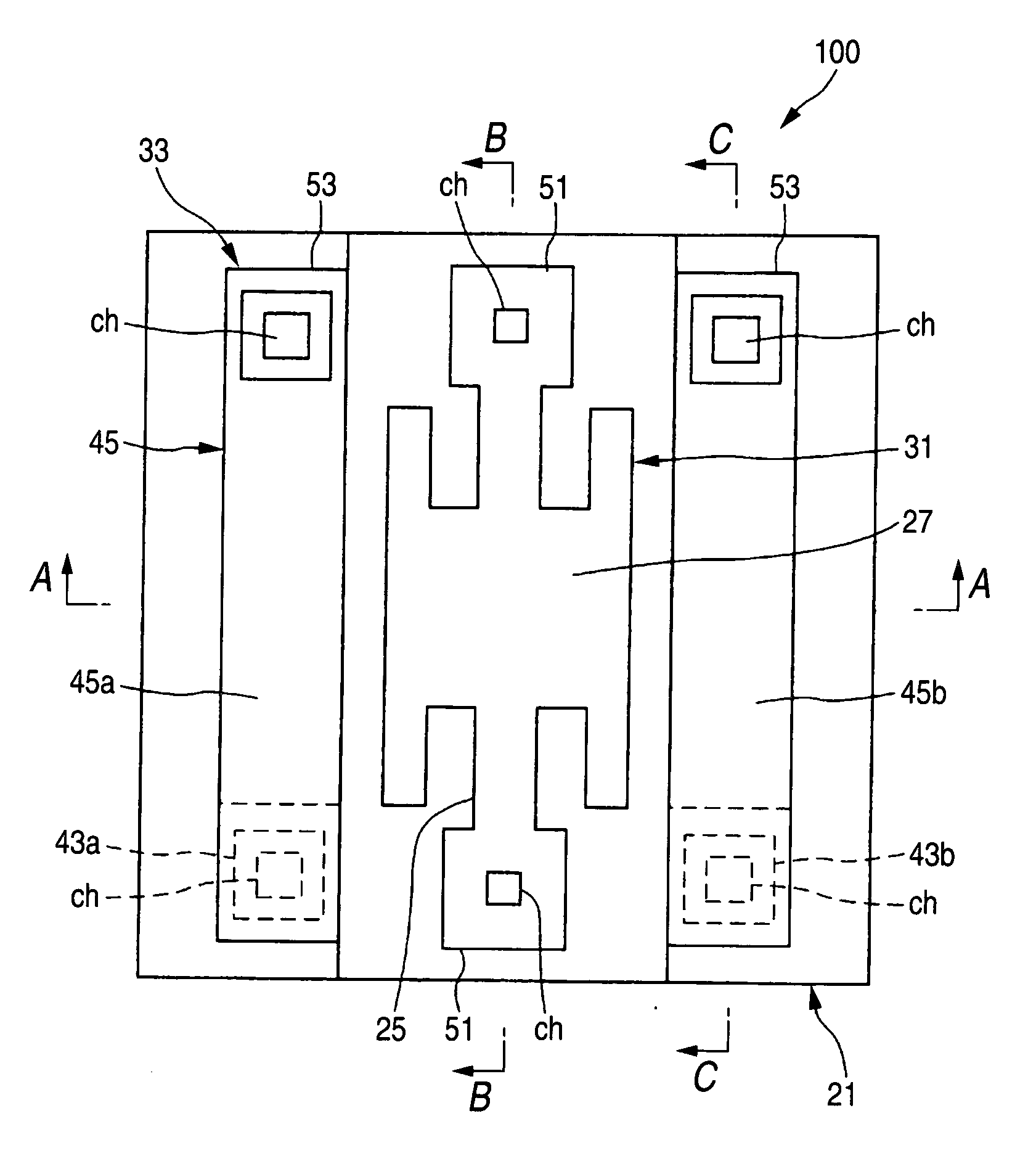Spatial light modulator, spatial light modulator array, and exposure apparatus
- Summary
- Abstract
- Description
- Claims
- Application Information
AI Technical Summary
Benefits of technology
Problems solved by technology
Method used
Image
Examples
first embodiment
[0100]FIG. 1 is a plan view of a spatial light modulator according to the present invention; FIGS. 2A to 2C are cross-sectional views, wherein FIG. 2A is a cross-sectional view taken along line A-A shown in FIG. 1, FIG. 2B is a cross-sectional view taken along line B-B shown in FIG. 1, and FIG. 2C is a cross-sectional view taken along line C-C shown in FIG. 1; FIG. 3 is across-sectional view of the substrate shown in FIG. 1; and FIG. 4 is an electrode wiring diagram of the spatial light modulator shown in FIG. 1.
[0101] As shown in FIGS. 1 and 2, a spatial light modulator 100 of the present embodiment has, as a basic structural elements, a substrate 21, a movable member 31 having a light reflector (hereinafter also called a “mirror section”) 27 and a conductive section 29 provided in at least a portion of the movable member, and a fixed electrode 33. In the light reflector 27, a beam 25 (also called a “hinge”) is provided so as to hang across the substrate 21 by way of a void 23, and...
second embodiment
[0151] A spatial light modulator according to the present invention will now be described.
[0152]FIG. 8 is a plan view of the spatial light modulator of the second embodiment attached to the beam of a separate mirror section, and FIG. 9 is a cross-sectional view taken along line D-D shown in FIG. 8. In embodiments and modifications provided below, those elements which are the same as those shown in FIGS. 1 through 7 are assigned the same reference numerals, and repeated explanations thereof are omitted.
[0153] In a spatial light modulator 200 of the present embodiment, a movable member 63 differs from the movable member 31. Specifically, the light reflector is embodied as a separate mirror section 65 attached to the hinge 25. The mirror section 65 is provided at least at an entrance opening section formed in the hinge 25. For instance, the mirror section 65 is newly formed, on the hinge 25 made of metal such-as aluminum, from the same material as that of the hinge 25. The mirror sect...
third embodiment
[0168] A spatial light modulator according to the present invention will now be described.
[0169]FIG. 13 is a plan view of a third embodiment of a spatial light modulator according to the present invention; FIGS. 14A to 14C are cross-sectional views, wherein FIG. 14A is a cross-sectional view taken along line E-E shown in FIG. 13, FIG. 14B is a cross-sectional view taken along line F-F shown in FIG. 13, and FIG. 14C is a cross-sectional view taken along line G-G shown in FIG. 13; and FIG. 15 is a electrode wiring diagram of the spatial light modulator shown in FIG. 13.
[0170] A spatial light modulator 300 of the present embodiment has the substrate 21; a movable member 73 having the hinge 25 provided so as to hang across the substrate 21, the mirror section 27 which is a light reflector capable of being vertically displaced by means of flexure of the hinge 25, and the conductive section 29 provided in at least a portion of the movable member; and the fixed electrode 33 disposed outsi...
PUM
 Login to View More
Login to View More Abstract
Description
Claims
Application Information
 Login to View More
Login to View More - R&D
- Intellectual Property
- Life Sciences
- Materials
- Tech Scout
- Unparalleled Data Quality
- Higher Quality Content
- 60% Fewer Hallucinations
Browse by: Latest US Patents, China's latest patents, Technical Efficacy Thesaurus, Application Domain, Technology Topic, Popular Technical Reports.
© 2025 PatSnap. All rights reserved.Legal|Privacy policy|Modern Slavery Act Transparency Statement|Sitemap|About US| Contact US: help@patsnap.com



